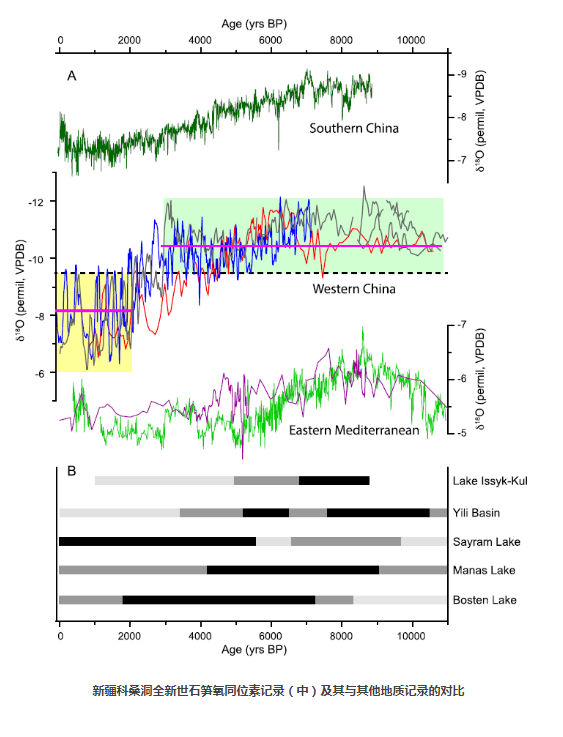Stalagmite data sets of Kesang cave in Xinjiang
Clicks:946
|
DOI
|
|
|
Key words
|
Stalagmite, Kesang cave
|
|
Related data
|
Central Asia lies at the convergence between the Mediterranean and Asian monsoon climates, and there is a complex interaction between the westerlies with the monsoon to form the climateof that region and its variability. The region is highly vulnerable to changes in rainfall,highlighting the need to understand the underlying controls. We present a stalagmite-based δ18Orecord from Kesang Cave in western China, using MC-ICP-MS U-series dating and stableisotope analysis. Stalagmite calcite δ18O largely documents changes in the δ18O of precipitation.δ18O in stalagmites was low during the early and middle Holocene (10.0-3.0 ka BP), and shiftedto higher values between 3.0 and 2.0 ka BP. After 2.0 ka BP, δ18O fluctuates with distinctcentennial-scale variations. Drawing from results of state-of-the-art atmospheric generalcirculation model simulations for the preindustrial period and 9 ka BP, we propose that changesin moisture source regions and the wetter climate both contributed to the isotopic depletion ofprecipitation during the early and middle Holocene. Multiple records from surrounding regionsindicate a generally wetter climate during the early and mid- Holocene, supporting ourinterpretation on the speleothem δ18O. Changes in precipitation seasonality do not appear to be aviable explanation for the observed changes, nor increased penetration of monsoonal moisture tothe study site. We speculate that the climatic regime shifted around 3.0-2.0 ka BP towards a drierclimate, resulting in temperature having dominant control on precipitation δ18O. The demise of
three settlements around 500AD at the margin of Tarim Basin coincided with a period ofdecreased precipitation and increased temperature that likely affected local water resources,underscoring the potential impact of climate on human habitation in this region.
|
|
Data description
|
a.Description of Intellectual Property Rights When using a dataset, please refer to the following documents in the article:
YanjunCai*, John C. H. Chiang, Sebastian F. M. Breitenbach, Liangcheng Tan, Hai
Cheng, R. Lawrence Edwards, ZhishengAn,2017. Holocene moisture changes in western China, Central Asia, inferred from stalagmites. Quaternary Science Reviews, ,158: 15-28
b. The data labels refer to the following specifications:
Data sources refer to the following specifications: East Asian Paleoenvironmental Science Database (http://paleodata.ieecas.cn/index.aspx),National Earth System Science Data Center, National Science & Technology Infrastructure of China (http://www.geodata.cn).
Acknowledgments refer to the following specifications:
Acknowledgement for the data support from “East Asian Paleoenvironmental Science Database (http://paleodata.ieecas.cn/index.aspx),National Earth System Science Data Center, National Science & Technology Infrastructure of China. (http://www.geodata.cn)”.
c. Contacts Name:
Cai Yanjun et al. & Data processing group
Company: Institute of Earth Environment, Chinese Academy of Sciences
Tel: 029-62336213
Email: zhaohl@ieecas.cn
|
|
Dataset format
|
excel
|
|
Data type
|
High-resolution geological and biological records/Stalagmite/Stalagmite
|
|
Data sources
|
authors supply
|
|
Enclosure
|
[download]
|
|
Related pictures
|

|
 Contact card Contact card |
 |
Name:Dr. Zhao |
E-mail:zhaohl@ieecas.cn |
| Company:IEECAS |
Telephone:029-62336213 |